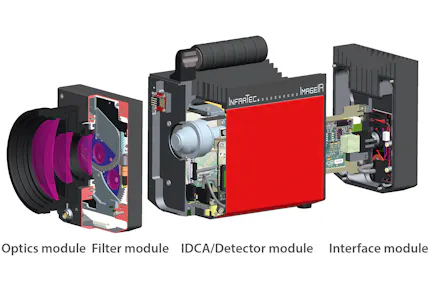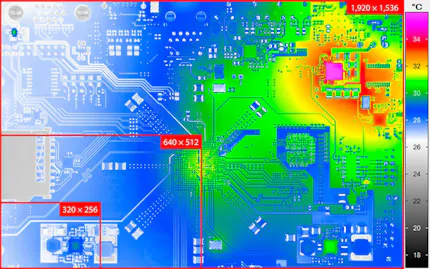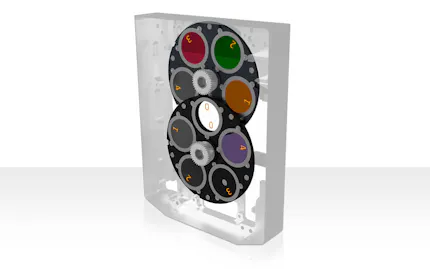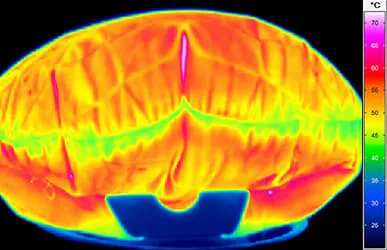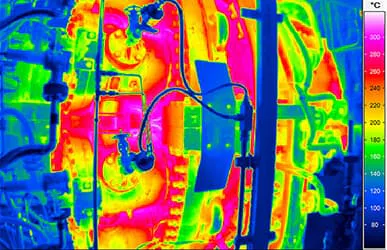Monitoring Plasma at Wendelstein 7-X
What will the energy supply of the future look like? The Max Planck Institute for Plasma Physics (IPP) in Greifswald is dealing with this question.
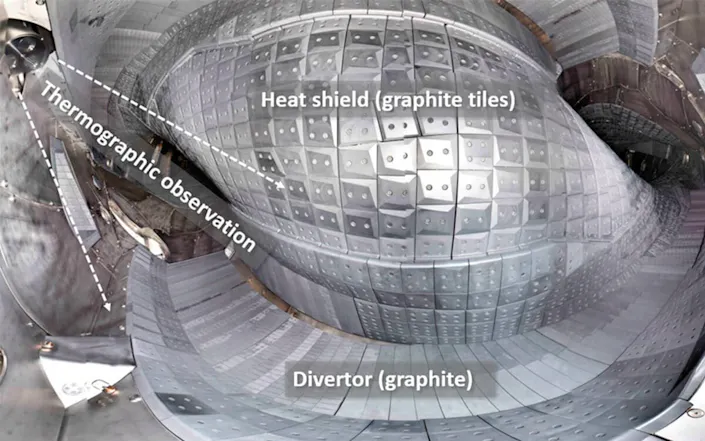
In accordance with the weightily initial question, the researchers can draw on an impressive research instrument. "Wendelstein 7-X is the world's largest stellarator-type nuclear fusion facility," says Dr. Marcin W. Jakubowski from Stellarator Edge and Divertor Physics Department at IPP. "It is intended to show whether this construction type is suitable as a permanently operated power plant.” The aim is to achieve plasma discharges lasting up to 30 minutes with this plant, in other words, half an hour of continuous operation. This would be an important preliminary work on the way to a form of energy production that does not require fossil fuels such as oil, coal and gas, does not produce CO2 emissions and does not further promote global warming. During the second experimental campaign, which ended in October 2018, discharges lasting up to 100 seconds were achieved. This is considered a world record for a fusion facility of this type.
InfraTec Solution
Max Planck Institute of Plasma Physics (IPP)
Institute Greifswald, Jakubowski, M.
www.ipp.mpg.de
Infrared camera
ImageIR® 9300
Although Wendelstein 7-X is an experimental facility, it is classified as a nuclear fusion reactor. In such plants, a gas mixture of deuterium and tritium is heated up to over 100 million degrees Celsius, in future. At such high temperatures, electrons and atomic nuclei separate and form plasma, which is electrically conductive. Atomic nuclei of the two hydrogen types deuterium and tritium fuse in this plasma. Helium nuclei are formed, neutrons are released as well as enormous amounts of energy, which can be used to generate electricity. The IPP is investigating numerous questions in which temperatures are of great importance. What happens during plasma discharges? Is it possible to achieve high temperatures with high inclusion densities at the same time? Can a plasma be generated that retains as much of its heat as possible in the core and does not transport it outwards?
Graphite Tiles Protect Divertor from High Plasma Temperatures
Temperature measurements in this context also play a central role. Therefore, at Wendelstein 7-X graphite tiles are thermographically monitored which cover parts of the inner plasma vessel, the divertor.
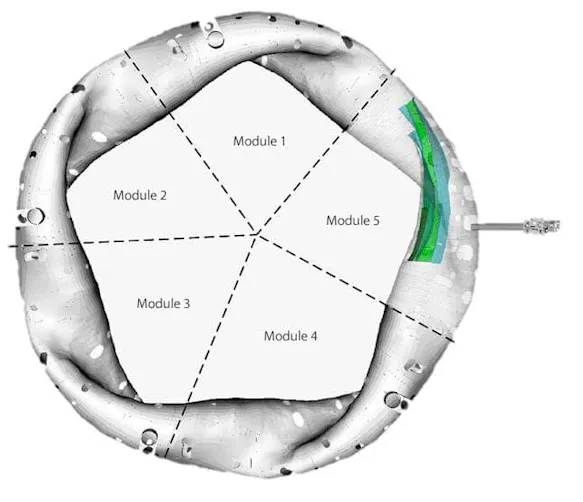
The tiles allow higher temperatures and longer plasma discharges. They especially protect the wall areas to which escaping particles from the edge of the plasma ring are directed. Together with impurities, the impinging particles are neutralized and pumped off. The temperature control is intended to prevent the system from being damaged by overloading and possible damage to the tile elements caused by plasma discharges not being detected.
This task is performed by special endoscopes equipped with thermographic cameras and visual cameras. "In the search for a suitable technical solution, we have experimented with various measurement instruments and methods. In the final analysis, it was clear that cooled thermographic cameras were best suited for our task," says Dr. Marcin W. Jakubowski. The InfraTec ImageIR® 9300 thermographic cameras are positioned at the end of each endoscope. To monitor the divertor, the infrared images are later superimposed with the CAD models of the plasma vessel.
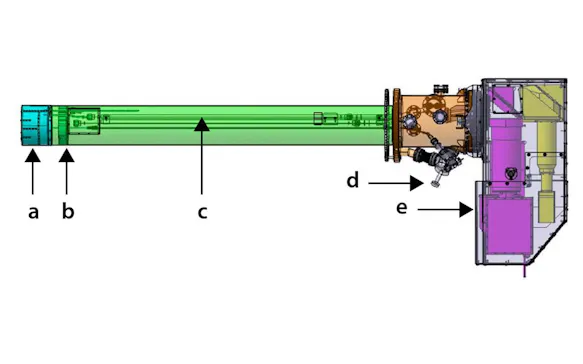
a – Front head
b – Cold aperture
c – Water cooling pipes
d – Shutter controller
e – IR camera holder
Use of the High-end ImageIR® 9300 Camera Secures Operation of the Fusion System
The scientists measure temperatures of up to 1,000 °C on the surface of the graphite tiles. In exceptional cases and locally very limited, up to 2,000 °C are registered. "Temperatures of more than 1,200 degrees Celsius are critical," explains Dr. Marcin W. Jakubowski. "If this happens, the divertor can be damaged and tile elements can come loose." If this were to happen, the system would have to be stopped and the divertor repaired. The consequence would be a forced break of at least six months.
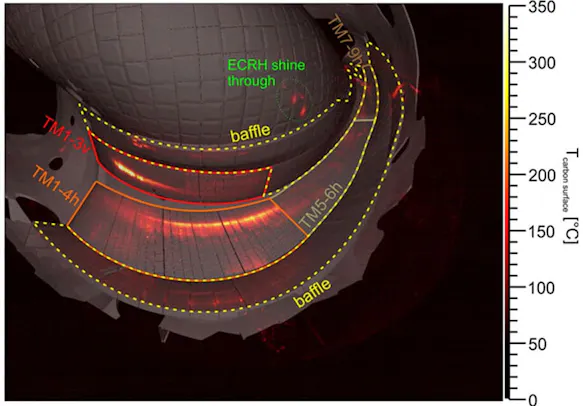
ECHR – Electron Cyclotron Resonance Heating, a main heating system of the plasma
TM1-3v, TM1-4h, TM5-6h, TM7-9h – Description of target modules whose temperatures are measured
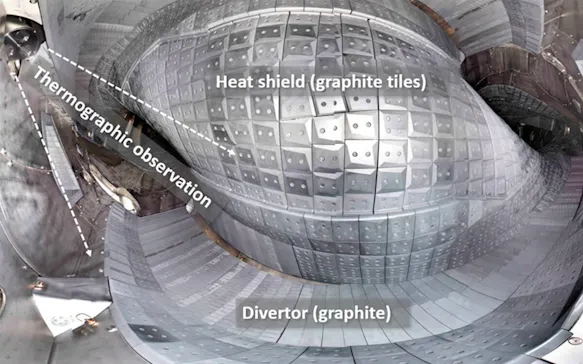
Precision and reliability are required so that Jakubowski and his colleagues are not slowed down. The ImageIR® 9300's internal filter wheel is equipped with multiple neutral density filters, providing the basis for accurate measurements over the entire, very wide temperature measurement range. High-resolution detectors with (1,280 x 1,024) IR pixels and corresponding special lenses ensure that large areas of the horizontal and vertical areas of the divertor can be monitored with a single image. The option of taking partial images at speeds of several kilohertz enables scientists to record even extreme short-term temperature changes.
Inner Lining of the Divertor to be Water-cooled in Future
The task of temperature monitoring will change again by 2020. Reasons for this are technical changes prior to the next experimental phases. Then the IPP would like to further increase the heating energy of the plasma and come decisively closer to its major goal of proving its ability to operate continuously. The inner wall of the vessel should of course not be overloaded. For this purpose, the current graphite plates will be replaced by water-cooled elements made of carbon fibre-reinforced carbon. Parallel to this, the integration of additional endoscopes is planned.
As a specialist for complex applications, InfraTec has relevant experience when it comes to successfully integrating modern and powerful thermography systems into research projects such as Wendelstein 7-X under technically demanding conditions and ensuring their continuous operation. The knowledge gained not only contributes to the development of future customer-specific solutions, but at the same time ensures synergy effects, for example in the installation or maintenance of comparable applications.
